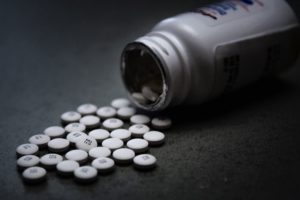The term ‘opioid epidemic’ or ‘opioid crisis’ refers to a surge in the rate of substance use disorder and escalation of overdose deaths that has been declared a Public Health Emergency in the US (Roehr 2017). Drug overdose has become the leading cause of preventable death in the US, and the rate of opioid overdose deaths has increased by 200% between 2000 and 2014 (Rudd et al. 2016). In 2016 more than 40,000 deaths were attributed to prescription or illicit opioids (Centers for Disease and Prevention 2018).
The current epidemic began in the late 1990s fuelled by increased opioid prescribing, direct marketing by drug companies to the public, unhelpful regulation and stigmatisation of addicts, and poor access to addiction treatment. It has many similarities with the first well-reported drug crisis of the late 19th and early 20th century. Opium, morphine, and later heroin were widely available and marketed for a host of disorders and ailments including the control of insanity, alleviation of cough, treatment of communicable diseases such as malaria, management of asthma, dyspepsia and hypochondriasis (Leigh 1785). Medicine was a highly competitive field and doctors needed to impress and retain patients to make a living. Effective remedies and treatments were limited, and morphine often alleviated troubling symptoms meaning patients would choose (and pay) the successful doctor again and again. The financial incentive at this time to (over) prescribe opioids meant that the medical professions struggled to encourage less harmful use of opioids. Some actively created addicts who were then beholden to them to obtain morphine or ‘cures’ at asylums with which they had an arrangement (Courtwright 2001).

By the late 1800s doctors were becoming more aware that prolonged use of opioids could lead to addiction, and that addiction had unpleasant health and social effects. They began to argue that the opioid drugs should be used sparingly, and for the short term only. Doctors became so reluctant to prescribe opioids that they were avoided even when they would have been appropriate. One wrote:
…that now they are in many instances so very afraid to give it, even for the worst pain, that the patient suffers agonies worse than any hell for want of one-eighth of a grain (Oscar C Young, cited Courtwright 2001 p 53).
A complication was added by the relatively rapid development of new forms of opioids, each heralded as less addictive than the earlier derivatives or synthetics. During the late 1800s and first half of the 1900s research led to the discovery of heroin (1874), oxycodone (1916), pethidine (1939), fentanyl (1959), and buprenorphine (1969). Physicians often switched patients to a newer preparation in an attempt to cure them of an addiction (Courtwright 2001). Despite the proliferation of new opioids the pendulum swung to create a different problem; under-use. This persisted for many years with prescribers fearful of opioid-use even for cancer pain. In the 1980s the World Health Organisation (WHO) gathered together a group of experts to discuss the problem of cancer pain and in 1986 published guidelines for its management (WHO 1986). Healthcare practitioners were becoming increasingly aware of the impact of poor pain management on the individual and society, and amid calls for ‘virtuous doctors’ to prioritise pain (Brennan et al. 2007). In 1990 pain experts called for pain to be ‘made visible’ and challenged attitudes towards opioids that made ‘clinicians afraid to administer opioids and patients afraid to take them’ with most patients being under-medicated (Max 1990: p 885).
To improve poor pain management healthcare professionals wanted to treat pain more aggressively and sought evidence that this was safe. Two key events supported the pendulum swing back to a more liberal attitude towards opioid prescribing. In 1980 a brief letter published in the New England Journal of Medicine stated that out of 11,882 hospitalised medical patients who had been given at least one opioid medication only four cases of addiction arose (Porter and Jick 1980). The letter went on to be cited 608 times up until March 2017, mistakenly used as evidence that opioid addiction was rare in patients being treated for acute and chronic pain (Leung et al. 2017). The second event was the launch of OxyContin onto the US market in 1996 by Purdue Pharma. Prescribers who were concerned by the risk of addiction were persuaded by the company that the risk of addiction in the management of chronic non-malignant pain was extremely small; less than one percent (Van Zee 2009). Prescriptions for opioids quadrupled between 1999 and 2014 (Centers for Disease and Prevention 2017). Physicians in the US became accustomed to prescribing opioids for post-operative pain, trauma and musculoskeletal pain and then issue further prescriptions for the patient to continue taking these drugs for several days or longer at home.

Pain patients are far less of an ‘addiction problem’ than those who divert the prescriptions, either gifting, selling, or having their opioid drugs stolen for use by others. However, the response to this ‘crisis’ has been to curtail the use of opioids for all patients, including those were able to experience an improved quality of life and increased function. Thus we see the pendulum swing back the other way. Addiction and pain management are complex areas in which there is limited education for health professionals and limited resources to bring together specialities. However, we must address the knowledge and skills deficit if we want to avoid the endless back and forth between liberalisation and fear that leaves patients trapped in pain and/or addiction.
References
Brennan, B.F., Carr, B.D. & Cousins, B.M. (2007) Pain Management: A Fundamental Human Right. Anesthesia & Analgesia, 105(1), 205-221.
Centers for Disease Control and Prevention (2018) U.S. drug overdose deaths continue to rise; increase fueled by synthetic opioids | CDC Online Newsroom | CDC.
Centers for Disease Control and Prevention & US Department of Health and Human Services (2017) National Vital Statistics System: Mortality.
Courtwright, D.T. (2001) Dark Paradise: a history of opiate addiction in America, Harvard University Press.
Leigh, J. (1785) An experimental enquiry into the properties of opium, and it’s effects on living subjects: with observations on its history, preparations, and used: being the disputation which gained the Harveian prize for the year 1785, Edinburgh.
Leung, P.T.M., Macdonald, E.M., Stanbrook, M.B., Dhalla, I.A. & Juurlink, D.N. (2017) A 1980 Letter on the Risk of Opioid Addiction. The New England Journal of Medicine, 376(22), 2194-2195.
Porter, J. & Jick, H. (1980) Addiction Rare in Patients Treated with Narcotics. The New England Journal of Medicine, 302(2), 123-123.
Roehr, B. (2017) Trump declares opioid public health emergency but no extra money. BMJ (Clinical research ed.), 359, j4998.
World Health Organisation (1986) Cancer Pain Relief, World Health Organisation, Geneva.
